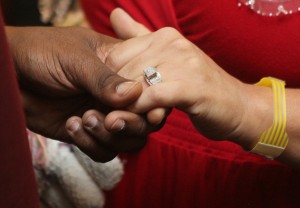BYU students Bryan Kubricht from Texas and Li Ping Su from Taiwan fell in love in Hawaii. Their marriage was a union of two people and two cultures.
Su and Kubricht have been married for seven years and both study marriage and family therapy at BYU. They also co-facilitate the Intercultural Couples Group offered by the BYU Comprehensive Clinic, which is a group where intercultural couples can meet and share their experiences.

Intercultural couples benefit from the mixing of cultures in exciting ways but also face a set of unique challenges.
Su said language barriers were an early challenge in their marriage, because she was raised speaking Chinese and was still learning English when she got married.
“Sometimes I will say the wrong word and get into an argument,” Su said. She said that not all intercultural couples have a language barrier, but their communication styles will still differ.
Su said in Chinese culture, people are direct with their criticism and in America most people use what Su calls the “sandwich technique.”
“They give a compliment, criticize … and give another compliment,” Su said.
Communication is key
Su and Kubricht have identified their different techniques for communicating so they can understand each other’s intentions and avoid being offended.
Jennifer Langi, the Multicultural Student Services cultural programs coordinator, was born and raised in Mexico in an intercultural family; her father is Mexican and her mother is Lumbee Indian. She has been married to her Tongan husband, Maloni Langi, for five years.
Langi said that her and her husband’s communication styles differ greatly, but she suggests this difference is not a result of their cultural backgrounds but because of their different family cultures.
“We’re all the product of our family culture,” Langi said. “(We’re) what our parents made of us and we have an opportunity to meld this new culture and just make it better and better.”
More holidays to celebrate
Kubricht also explained that another aspect of intercultural marriages is negotiating cultural traditions and holidays between couples, which he said can be challenging and exciting.
“It is very apparent that you have to negotiate values and traditions right off,” Kubricht said. “This is a benefit because many couples will assume they don’t need to talk because they are from the same culture and differences reveal themselves later, whereas with intercultural it is obvious.”
Kubricht said an extra perk of bringing two cultures together is the experience of celebrating more holidays. He especially loves celebrating traditions from his wife’s culture.
“I get the benefit of more holidays to celebrate … like Chinese New Year,” Kubricht said.
Guys: Save the culture chat for the 2nd date
Victoria Stewart from Argentina came to BYU to study Spanish teaching. When she arrived, Victoria was asked out on many dates but felt like the men ignored her and were only interested in her culture.
Her dates felt repetitive as multiple Spanish-speaking returned missionaries took her on dates and only asked her about life in Argentina.Then she met Matt Stewart: a Utah native at BYU who hopes to go to dental school.
“He treated me as a normal person because of my personality and not because I’m from Argentina,” Victoria said. “(It was) about having fun and getting to know each other.”
Matt had never pursued an intercultural relationship and was able to see Victoria for more than just her ethnic background.
“I never thought I was going to marry someone from another country,” Matt said. “I was never like, ‘Oh I’m going to marry a foreign girl.'”
Teaching diversity
Su said when couples with different cultural backgrounds marry they have the opportunity to form a personalized blended family culture.This blending helps children of intercultural couples be more comfortable with diversity and get more exposure to various cultures early in life.
“It’s good for children to get exposed (to other cultures),” Kubricht said. “(They) become comfortable in many different settings.”
However, it is not just children that can benefit from being exposed to multiple cultures. Langi loves the family values shared between her culture and her husbands and feels that she has become closer to her husband.
“A neat benefit I’ve found is a strong emphasis on family in all three cultures (Lumbee, Mexican and Tongan),” Langi said. “It’s been so nice to see us grow into each other.”




